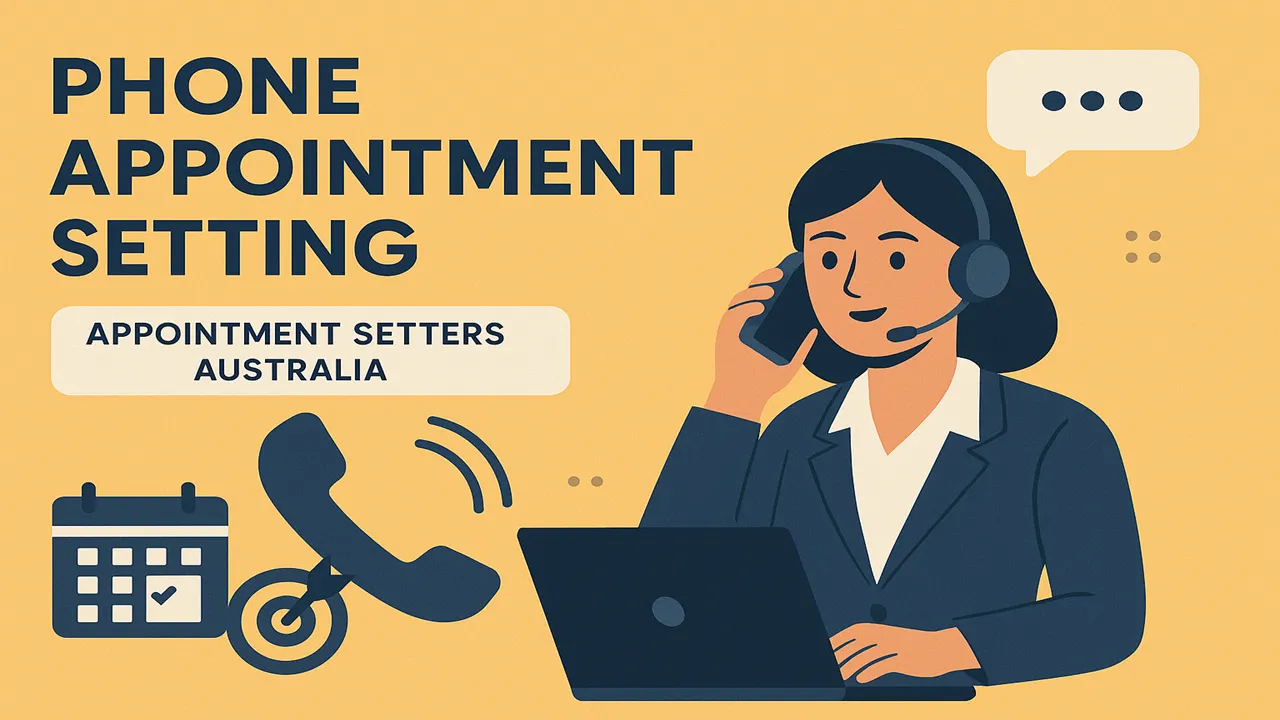In the world of business-to-business (B2B) sales, telemarketing appointment settings are crucial for getting meetings with potential clients. This process involves calling businesses to arrange times for salespeople to meet with decision-makers.
B2B Appointment Setting through telemarketing is all about carefully planning who to contact and how to convince them to meet. It helps businesses grow by directly reaching out to the right people, explaining their products or services, and setting up meetings for deeper discussions.
Here’s how it works: First, companies research which businesses would be interested in what they offer. Then, trained telemarketers call these businesses to talk about how their products or services can help. The goal is to persuade them to schedule a meeting with a salesperson.
This approach is effective because it’s personalized and focused on solving each business’s specific problems. It’s not just about making calls it’s about building relationships and creating opportunities for sales. By doing this well, businesses can turn potential leads into loyal customers.
Telemarketing appointment settings are essential for B2B companies looking to grow. They ensure that sales efforts are targeted and efficient, leading to more meaningful connections and better business opportunities.
The Essential Guide to Telemarketing Appointment Setting
In the world of business-to-business (B2B) sales, knowing how to set up appointments through telemarketing is really important. This guide covers all the key strategies and techniques that can help you become great at setting up these meetings.
What is Telemarketing Appointment Setting?
Telemarketing appointment setting is when you call businesses to schedule meetings. It’s about convincing decision-makers to meet with you by showing how your product or service can solve their problems.
Tips for Success
To succeed, you need to prepare well. Research your prospects so you know what’s important to them. Be clear and polite on the phone, and be ready to handle any concerns they might have. The goal is to smoothly guide the conversation towards setting up a meeting.
Tools to Help
Using tools like CRM systems and dialer software can make your job easier. These tools help you keep track of who to call next, automate follow-up emails, and give you data to improve your approach.
Creating a Good Script
A good script is like a roadmap for your calls. It should be friendly and focused, highlighting the benefits of meeting with you. But it’s also important to be flexible and adapt to how the conversation goes.
Measuring Your Success.
Keep track of how well you’re doing. Look at things like how many calls lead to meetings. This helps you see what’s working and what you can do better.
Effective Strategies for Telemarketing Appointment Settings
In a B2B appointment setting, using effective strategies is key to success. Telemarketing appointment settings involve careful planning to arrange important meetings between businesses. To do this well, it’s important to understand your target audience. Researching potential clients helps tailor your pitch and how you set up appointments. This personalized approach not only boosts your chances of getting meetings but also makes your interactions more meaningful, building better relationships with clients.
Using technology is also really helpful. Tools like CRM systems help manage contacts, track interactions, and schedule appointments smoothly. Automation tools can handle repetitive tasks, giving you more time to focus on talking with clients and closing deals.
Good communication skills are vital too. Clearly explaining what you offer and listening actively to client needs helps capture their interest quickly. This makes it easier to show how your services can solve their problems and convince them to meet with you.
Lastly, staying power can pay off. Following up after your initial contact in a friendly but professional way shows you’re reliable. A well-planned follow-up strategy keeps prospects interested and increases your chances of turning meetings into deals.
Successful telemarketing appointment setting means planning carefully, using technology wisely, communicating clearly, and staying persistent. These strategies help businesses reach out effectively and set up valuable meetings in the competitive world of B2B sales.
Everything You Need to Know About Telemarketing Appointment Settings
When it comes to business sales and finding new customers, mastering telemarketing appointment settings is really important. It’s all about scheduling phone calls with potential clients to set up meetings or sales opportunities.
To do this well, you need to understand your target audience know what problems they have and how your product or service can help. Your team also needs to be great at talking to people and convincing them why they should meet with you.
Appointment setting services can make this easier. They specialize in organizing these calls and managing customer information so no opportunities are missed. They use technology to schedule calls at the best times and make sure each call is effective.
Successful telemarketing appointment settings also involve good preparation. Before calling, it’s important to research the person you’re calling and understand their needs. After the call, following up quickly shows you’re serious about meeting their needs.
By focusing on these things, businesses can improve their sales efforts, make more appointments, and build better relationships with customers.
Mastering telemarketing appointment setting is about being smart with your approach, communicating well, and using helpful services to make the process smooth and effective. This way, every call can lead to a valuable opportunity for your business.
Telemarketing Appointment Settings: Best Practices and Techniques
Telemarketing appointment setting is all about arranging meetings over the phone with potential clients. It’s a crucial step in turning leads into actual sales opportunities, whether you’re selling to businesses or individual customers.
- Start Strong: Begin with a clear introduction. Let the person know why you’re calling and how your product or service can benefit them. Respect their time and show you value it.
- Ask the Right Questions: Understand the person’s needs and whether they have the authority to make a decision. This allows you cognizance on leads which might be maximum probably to convert.
- Build a Connection: Be friendly and professional. Building a rapport makes it easier to set up a meeting. Listen carefully and show that you understand their situation.
- Set Clear Expectations: Be upfront about why you want to meet and how long it will take. This helps them prepare and shows that you’re organized and respectful of their time.
- Follow Up: Not every call leads to an appointment right away. Have a plan for following up with those who need more time to decide. It could be sending more information or scheduling another call.
Step-by-Step Guide to Successful Telemarketing Appointment Settings

Setting successful appointments through telemarketing is all about planning and effective communication. Follow these steps:
- Know Your Audience: Start by understanding who you’re calling. Know their interests and needs so you can tailor your pitch.
- Create a Good Script: Write a script that’s friendly and persuasive. Make sure it explains why your offer is valuable. Use clear and simple language.
- Use Good Contact Lists: Make sure your phone numbers are correct and up-to-date. Keep track of your calls and use tools to help you remember important details about each person.
- Call at the Right Time: Try calling when people are more likely to answer, like in the morning or early afternoon. Avoid calling throughout busy times.
- Listen Well: Pay attention to what the person on the phone is saying. Show you’re interested by asking questions and responding to what they say.
- Handle Concerns Nicely: Be ready for questions or worries people might have. Stay calm and solution politely.
- Follow Up: If someone isn’t ready to make an appointment right away, follow up with them later. Keep in touch and remind them of your offer.
- Review and Improve: Look at how well your calls are going. Learn from what works and what doesn’t. Try new ideas to make your calls even better.
Top Tips for Improving Telemarketing Appointment Settings
Improving how you set up appointments through telemarketing is crucial for boosting your success. Here are a few easy but powerful tips:
- Clear Scripts: Use scripts that are easy to follow and sound natural. Personalize them to match each prospect’s needs.
- Know Your Leads: Focus on leads who are most likely to buy. Consider factors like their budget, authority to decide, and specific needs that match your offerings.
- Listen Well: Encourage your team to listen actively. Understanding what prospects need helps you offer the right solutions and build rapport.
- Manage Time: Respect prospects’ schedules. Offer appointment times that work for them, increasing the chances they’ll attend.
- Use CRM Tools: Keep track of interactions and schedule follow-ups using CRM (Customer Relationship Management) software. It helps you stay organized and ensures no lead slips through the cracks.
- Training: Regularly train your team on new products and how to handle objections. Confident agents make better calls.
- Feedback: Create a system where your team can share what’s working and what’s not. Use this to improve your approach over time.
- Monitor Results: Keep an eye on key numbers like how many appointments lead to sales. This helps you see what’s working and where you can do better.
- Stay Flexible: Be ready to adjust your approach based on what you learn. Markets and customer preferences can change, so stay adaptable.
- Stay Legal and Ethical: Follow rules and respect your prospects’ privacy. Building trust is key to successful appointments.
How to Create Effective Scripts for Telemarketing Appointment Settings
Creating effective scripts for setting appointments through telemarketing is crucial for successfully reaching out to businesses. Start by understanding who you’re calling and what challenges they face. Your script should quickly grab their attention by addressing these challenges right away.
Introduce yourself and your company clearly and briefly. For example, “Hi [Prospect’s Name], I’m [Your Name] from [Your Company]. We help businesses like yours [solve a specific problem]”.
Include open-ended questions in your script to encourage conversation. This shows you’re interested in their needs and helps you tailor your pitch better. Be ready to handle common concerns they might raise, showing that you understand their situation and can provide solutions.
Focus on the benefits of your service rather than just its features. Explain how your solution can make their business better. End your script with a clear request for the next step, like scheduling a call or getting more details.
By crafting a script that speaks directly to your audience’s needs and emphasizes how your service can help them, you’ll increase your chances of setting successful appointments. Don’t forget to review and improve your script based on feedback to keep getting better results.
The Role of Data in Telemarketing Appointment Settings
Telemarketing appointment setting is all about using data smartly to arrange meetings with potential clients over the phone. It’s crucial because it helps connect with the right people effectively.
Data is like the secret sauce in this process. It helps by figuring out who your best prospects are based on things like their background or how they’ve interacted with your company before. This makes it easier to reach out to people who are genuinely interested in what you offer, which saves time and boosts your chances of making successful connections.
Another big help from data is personalization. By knowing more about each prospect, like their preferences or past interactions, you can tailor your messages to resonate better with them. This personal touch makes your calls more engaging and builds trust, which is key for turning appointments into sales.
Data also lets you learn from each call. By analyzing how different approaches work, you can improve your strategies over time. This might mean adjusting what you say or when you call to get better results. It’s a way to keep getting better at what you do.
When you outsource appointment setting to experts, they bring specialized skills and tools for handling data smoothly. They ensure everything is accurate and meets legal rules, and they can even integrate with your systems seamlessly. This makes your whole appointment-setting process more efficient and effective.
In short, using data wisely is the backbone of successful telemarketing appointment settings. It helps you target the right people, personalize your approach, learn what works best, and make outsourcing work smoothly. It’s all about using information to make your phone calls count.
How to Optimize Your Telemarketing Appointment Settings Campaigns
Optimizing your telemarketing appointment setting campaigns means making them work better so you can turn more prospects into scheduled meetings. Here are some straightforward tips to help you do that:
- Know Your Audience: Figure out who you’re calling and what they need. Divide them into groups based on things like their job, industry, and what problems they have. This enables you communicate to them in a manner that makes sense.
- Have a Good Script: Write a short, convincing script that focuses on why your product or service is helpful. Address any concerns they might have, too.
- Call at the Right Time: Call when people are likely to pick up and listen, not when they’re busy. Also, don’t call too often or you might annoy them.
- Use CRM Tools: Use software that helps you keep track of your leads and schedule follow-up calls. This makes it easier to stay organized and focus on the most promising leads.
- Train Your Team: Teach your callers how to handle objections politely and explain your product or service clearly. Listen to calls regularly to see what’s working and what needs improvement.
- Test Different Approaches: Try different ways of talking and calling times to see what gets the best response. Use what you learn to improve your strategy.
- Coordinate with Online Marketing: Make sure your telemarketing matches up with your online ads and emails. This makes your message consistent and stronger.
- Follow Rules and Be Respectful: Always follow telemarketing rules and respect people’s privacy. If someone doesn’t want to be called, don’t call them.
By focusing on these steps, you can make your telemarketing calls more effective and friendly, which can lead to more successful meetings with potential customers.








